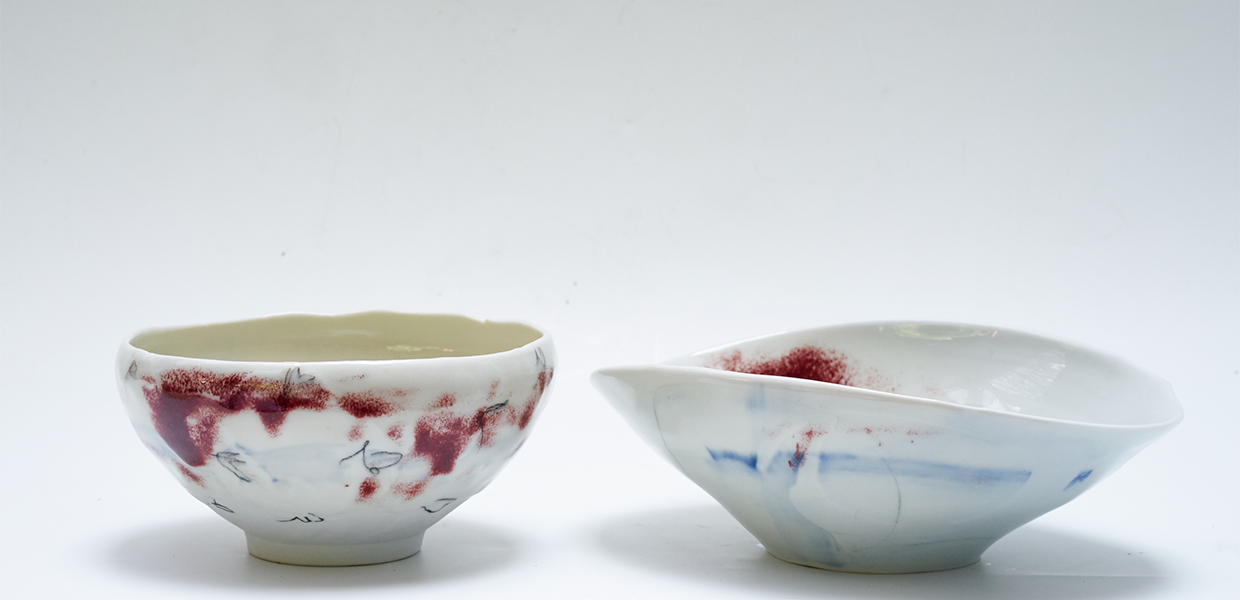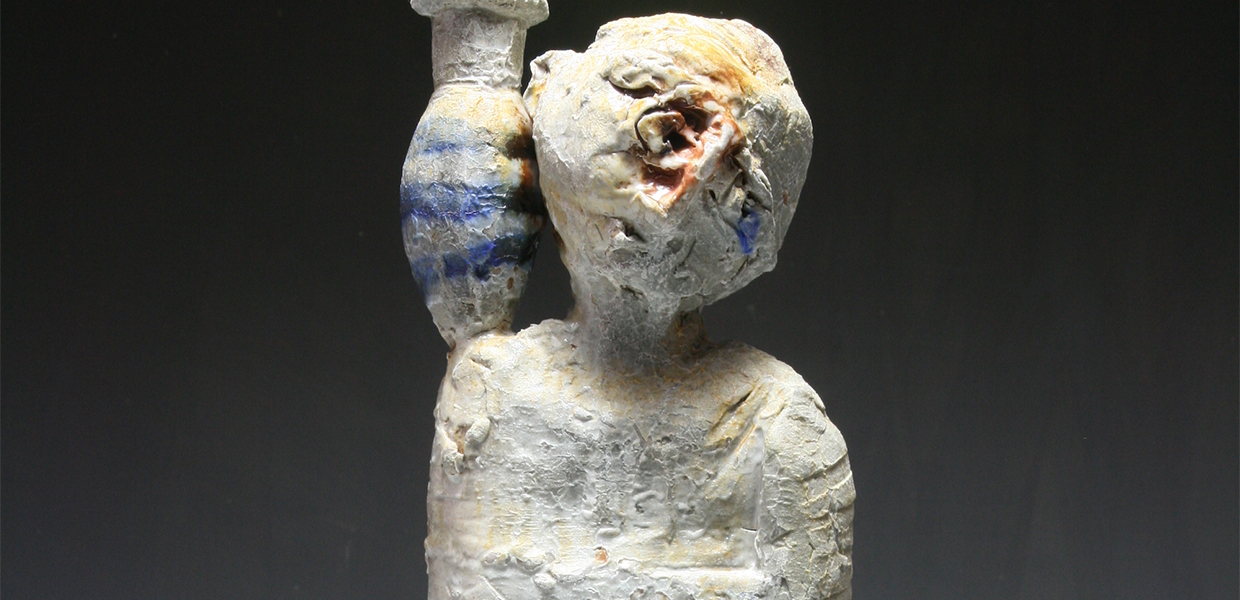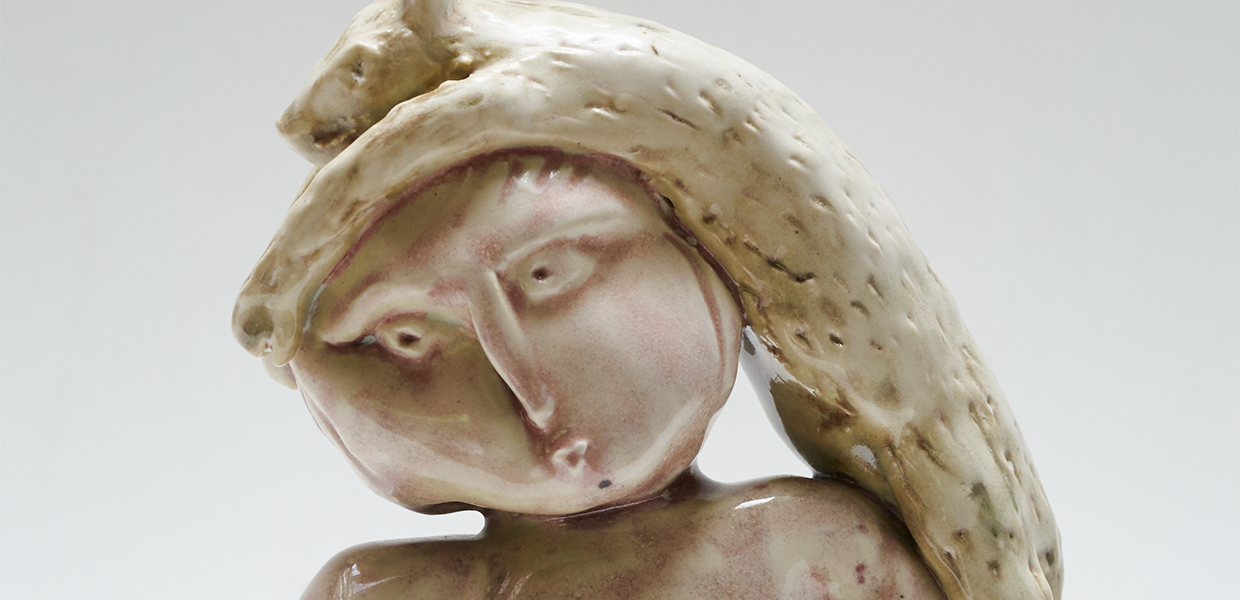Catherine Lane
Could you give a brief description of your current practice and the number of years you have been involved in ceramics?
I began working with clay when I was a teenager and was lucky enough to be taught in high school by Rod Bamford the late Frederick Chepeaux – very different artists working at different ends of the spectrum, but equally inspirational.
Commonalities and points of connection between human beings and other creatures is the current focus of my practice, driven by personal observation of our ever increasing distance from the natural world. Using a visual, tactile language my work engages with ordinary experiences of the human condition and explores the way humans relate to other humans and also to familiar animals that share the same environment.
A key intention is to invite the viewer to develop a closer understanding and a different appreciation of relationships often overlooked and unseen. Humour, empathy, narrative, expression and simplicity of form become entry points into the work, increasing accessibility so as to invite closer inspection. Artworks comprising several components experiment with different ways a viewer can relate to the work in an effort to stimulate and reflect on personal and cultural experiences.
Although the bed of my practice lies in the ceramic tradition which is still thoroughly rewarding for me, current collaborative works have expanded to encompass a variety of mixed media determined specifically for each project by relevance to the concept. It concerns me that my practice up to this point has relied so heavily on significant amounts of the earth’s resources and I find myself in a position of flux. Much of the inspiration for my work comes from the immediate fragile location in which I live, on a watercourse within walking distance to the beach on the far north coast of NSW and poignantly, contemporary global concerns about the impact of climate change and the need for direct action to protect vulnerable species increasingly make my message more urgent. Technical skill, a personal aesthetic and the significant knowledge gained working with clay for many years continue to underpin and inform my practice, but no longer solely define it.
When and why did you move to the Northern Rivers of NSW?
When I finished my undergraduate studies at Charles Sturt University, I returned to the family home in Coffs Harbour, uncertain how my career might progress from there. Periodically, I would visit my artist brother in his renovated cow bails at Tintenbar and dream about living on the north coast, but for the most part, my job at Lake Russell Gallery filled my days. I was frustrated that I had no studio space where I could make objects. So, I wrote to Bob Connery at Stokers Siding Pottery asking if I could go and work with him and Laine Langridge as it was one of the only potteries I knew about and so I moved north for the summer. As it turned out, the pottery itself was in a position of flux and Laine was no longer there, but Andrew Stewart had taken a partnership role. It was the summer the roof blew off the pottery in a cyclone, so suddenly there were other priorities for Bob and I slid quietly out of the way only months after I arrived.
That period of time offered me a fabulous opportunity to discover more about the Tweed Valley and the surrounding region.
However, it was not until 1991, that I got to return to live and work with my partner in our own purpose built studio in Uki. Steve Davies and I knew each other from university, but that had only grown in to a fruitful partnership after I joined him in a small pottery studio in Japan as a trainee in 1986. Following our time working there and subsequent travels, we established a small studio first in Kororo, and later in Bonville just south of Coffs Harbour and idealistically began making work in makeshift studio spaces. After buying land in Uki, we built a studio – the house came soon after.
The decision to live and work regionally has always been a very conscious one and was both financial and lifestyle driven.
What part(s) of the Northern Rivers have you worked in and can you tell us about the type of work you have delivered?
Following a summer stint with Bob Connery and Andrew Stewart at Stokers Siding Pottery, which was my first taste of a working studio, I did not return to the northern rivers until the start of the nineties. At Stokers, being so young I lacked the discipline of my mentors but it was a fruitful and memorable experience for me. My work ethic didn’t really kick in until my training in Japan which came a bit later.
Since the early nineties, I worked as a teacher in TAFE NSW – mostly based in the Visual Arts faculty in Murwillumbah. I also advised on the development of the new space when the campus expanded. Over the years, as the popularity of ceramics trended in and out, I taught across other areas including drawing, professional practice, design and sculpture which coincided with a shift in my own practice. TAFE allowed me to pass on various skills, but also offered me an opportunity to interact directly with my local community in a way private practice didn’t. I have been both humbled and proud to watch ex-students thrive in furthering their own careers.
Over the years, I have delivered random workshops and classes here and abroad but currently to be no longer teaching regularly in any capacity is really quite a shift.
Has living and working in a regional area defined your arts practice parameters? Have you considered your location restricting or motivating?
Without a doubt, being regional has defined my practice and defined my identity as an artist – to myself, at least, despite me consciously and flexibly reworking those boundaries! It’s my environment that provides me with constant inspiration and I would find it challenging to live away from the green lushness, the water, the smells and sounds of this space for long. My studio space is small and intimate, but intrinsically connected to my living space and my locale. Having said that, I don’t work in a vacuum, and my approach to maintaining currency and keeping the work fresh (for me to make and others to respond to), demands that I put energy into maintaining networks and a supportive like-minded community of kindred souls around me.
It’s a process of constant re-evaluation – who am I making this for? where is my market? what kind of service am I providing? does this work sit with my values? does this work reflect me? what is it I am trying to achieve?
Had I been in a city, given the different opportunities that reside there, I know in my heart I would have had a different kind of practice and perhaps a different place in the broader ceramic scene, but I cannot miss something I have never had and I can’t go backwards. Increasingly, different opportunities are opening up in this regional community as it changes to accommodate new people. You only have to look at the number of people now working with clay to understand the cycle is on the up again for the moment and perhaps is shifting permanently as notions of a smaller footprint and sustainability infiltrate conversations and marketplaces everywhere.
I think also the notion of distance education makes learning more accessible for regional artists to upskill or go deeper into their practice from a home base which brings more opportunities. Education has become so expensive that being able to choose the best location with a supervisor in sync with your ideas is critical to the quality of the end result.
Has your practice undertaken major changes/challenges in your more mature years?
I read this question and think :’oh yes, I remember now…… I’m getting old.”
On reflection, I would have to say over the years, the biggest challenge was maintaining a presence in the industry whilst at the same time juggling working and solo parenting. Finding the time and the mental energy required to develop a body of work for exhibition requires dedication and time and there were definitely periods when my capacity to do this was strained and limited. Looking back, I wonder how I did it, but somehow you just do.
Undoubtedly at the present time, the most critical challenge to my practice is physical limitation which is something I’ve never experienced before. After a very intense working stretch, I sustained a repetitive strain injury last year which saw me lose movement completely in the thumb on my right hand. Being right-handed, this was a blow I hadn’t predicted. It was fast followed buy a left shoulder injury, most likely from compensating for the thumb and both were very painful. Quick reality check: maybe I won’t be able to work forever the way I had always imagined. When the anger dissipated (anger at myself as well as the aging process), I sat down and reassessed why I was doing what I was doing. The decision to tighten my parameters, to only take up the projects that really interested me, and to forgive myself for not pursuing a higher profile from my work were all reinforced. I reminded myself that there are alternative definitions of success. Teaching had offered me a meagre, but predictable kind of income which in the end was whittled away by the extra time spend in unpaid hours, the stress of working with people who were not always committed and the ongoing political rhetoric that underpinned a lack of understanding about the value of the teaching role. This in turn had meant constant stress in relation to vulnerability in paid working hours. In the end, I came to understand that the safety net I had thought teaching was, was only a fabricated ideal. It wasn’t a safe job. It wasn’t even a base wage. Crucially, on reflection, I realised that I could afford a different strategy because the hardest years of solo parenting were now behind me and the only risk was to myself, so I could afford to think differently about my path.
I am now working on diversification of my income sources to alleviate pressure on my practice. I lead a simple, frugal kind of life so I believe it’s achievable.
How have you maintained your passion for your practice over the years?
There has never really been a time when I stopped making objects, although my capacity to access studio space has not always been easy. There is something very honest and grounding about working with clay. Being one of the oldest crafts, it links me to makers from thousands of years ago, and that makes me quietly determined to honour the material and not waste resources.
Pitfalls, regular failures and frustrations aside, the tactility and responsive nature of the material brings me joy.
Despite my role as an educator, I had always strived to maintain an exhibition profile no matter how limited my studio time was. There was a time, maybe ten years ago, when I had to access a studio space away from home and was juggling the role of single parenthood with teaching, I questioned whether or not I was being silly and frivolous to pursue ceramics in any way. I was filled with self-doubt. At the time, it was a very weighty question because it seemed completely indulgent to be thinking about spending precious resources to construct something that only I would use. Additionally, because of my other commitments, (especially my uncompromising stand when it came to what I needed to give my family) and because I lived regionally, I knew that if I wanted to be a major player in the field it would take more effort than perhaps in reality I had to give. I was not mixing with industry peers and I was unable to keep up with exhibitions the way you need to at the highest level. In that mix was an honest acknowledgement to myself that I lacked the competitive spirit that drives leading practitioners but it didn’t mean there wasn’t a place for me somewhere.
While I was tossing all this around, I undertook a residency in Indonesia and from the works that came back to Australia, I had a piece I loved chosen out of left field by the late Janet Mansfield to be the winner of the Townsville Ceramic Award. It was a quiet, work that resonated with me in a way I did not expect anyone else to share and was the last professional role Janet assumed in ceramics before she died. The ensuing funds enabled me to build a modest studio at home and purchase a bigger kiln. More significantly, it was pivotal to my confidence in moving forward and validated the identity I had doubted.
Since then, I have kept a quiet promise to myself to only do the kind of work that excites me and has purpose – so this has led me in recent years to collaborate with fellow artist friends to challenge myself and re-establish the boundaries of what I do to my own definition. This newest part of my work practice, the cross-disciplinary collaborative element is really inspiring for me and to be able to work with other gifted artists always seems to result in a more exciting end product that is both richer and deeper. The lateral thinking it demands from me is really challenging, stimulating and exciting.
Do you use social media platforms as a useful resource for your work as an artist?
Probably not enough!
I remain ever hopeless in regard to Facebook and Twitter because although they seem to be highly regarded as tools by a lot of people, I have stubbornly resisted. I do have an Instagram account which I maintain as part of my professional practice and whilst erratic and somewhat haphazard in my approach, it does seem to be a good platform for maintaining connections without taking up massive amounts of time. The insecure me still wonders why anyone would be interested in what I do. I have a lot of connections on Linked-In, and have met some previously unknown to me people working in the arts and associated areas there, but my preference remains face to face communications with colleagues and friends.
Are you concerned about sharing your skills and knowledge with the next generation of artists in your field?
This is an interesting question – especially now that I am no longer engaged in my formal teaching role. I am acutely aware that I see my mentors with all the knowledge and skills they possess getting older and it does concern me that their knowledge will be lost… I guess I’m making that shift upwards into the next generation.
I see a lot of renewed interest in clay by contemporary practitioners, as it’s clearly evident there is as resurgence in the notion of the handmade, but despite the fact that there are many very good makers out there, I still see work that either reflects poor skills (showing a very simplistic understanding of the material), or is technically outstanding only in one way at the expense of the end result. This certainly would suggest that skills are not being passed on as they once were. For me, it’s a case of learning the rules so you can break them which means underpinning knowledge of fire and flame. Although my studio space is small, if a student seriously wants to learn, is interested in my approach to the medium, and we rub along ok, we can usually come to an arrangement, but I would always advise a student to be eclectic in their knowledge base and gather it from far and wide.
It was one of the things in the end that frustrated me about formal teaching – the subject wasn’t given the holistic respect it needed (in terms of what I considered it needed in terms of delivery hours) to enable a comprehensive understanding and it’s not a subject you can skim the surface on and get away with. I think in my own history, the training I received early on in Japan was something quite special and was a discipline I didn’t really understand the value of at the time. Curiously, although my work has shifted around my skills base, that is always something I come back to. Almost all the processes and different techniques I use draw on my experiences from that period of time and certainly my current aesthetic has come full circle to embrace a certain eastern simplicity.
How do you see the future development of your arts practice?
Strangely, I can’t really define it… but I am strong in the knowledge that it will always be part of my reality. It’s in constant flux, as I am and so it shifts and morphs around those things that are important to me.
There ARE some things I know:
I know I will always make things.
I know I will be involved in more collaborations with other beautifully dedicated and committed artists. This is what inspires me.
I hope that my work will undergo a continuous process of refinement and be ever more relevant to the issues of importance to me so it can resonate better with an audience.
I know my curiosity and passion for texture and objects and history and our connections with nature – I know these things will only become stronger as the years go by. It’s a rich tapestry that weaves through my life and I embrace it.






